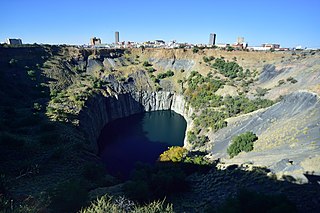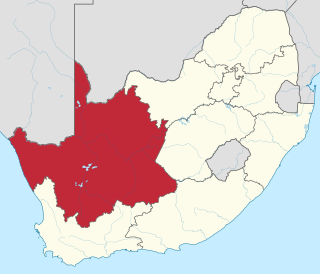
Kimberley is the capital and largest city of the Northern Cape province of South Africa. It is located approximately 110 km east of the confluence of the Vaal and Orange Rivers. The city has considerable historical significance due to its diamond mining past and the siege during the Second Anglo-Boer war. British businessmen Cecil Rhodes and Barney Barnato made their fortunes in Kimberley, and Rhodes established the De Beers diamond company in the early days of the mining town.

The Northern Cape is the largest and most sparsely populated province of South Africa. It was created in 1994 when the Cape Province was split up. Its capital is Kimberley. It includes the Kalahari Gemsbok National Park, part of the Kgalagadi Transfrontier Park and an international park shared with Botswana. It also includes the Augrabies Falls and the diamond mining regions in Kimberley and Alexander Bay.

The R31 is a provincial route in the Northern Cape of South Africa that connects Kimberley with the Namibian border at Rietfontein via Kuruman and Hotazel. It is co-signed with the R360 between Askham and Andriesvale.

The Iziko South African National Gallery is the national art gallery of South Africa located in Cape Town. It became part of the Iziko collection of museums – as managed by the Department of Arts and Culture – in 2001. It then became an agency of the Department of Arts and Culture. Its collection consists largely of Dutch, French and British works from the 17th to the 19th century. This includes lithographs, etchings and some early 20th-century British paintings. Contemporary art work displayed in the gallery is selected from many of South Africa's communities and the gallery houses an authoritative collection of sculpture and beadwork.

The Iziko South African Museum, formerly the South African Museum, is a South African national museum located in Cape Town. The museum was founded in 1825, the first in the country. It has been on its present site in the Company's Garden since 1897. The museum houses important African zoology, palaeontology, and archaeology collections.
Driekops Eiland is a rock engraving or petroglyph site in the bed of the Riet River close to the town of Plooysburg, near Kimberley, Northern Cape, South Africa.
Wildebeest Kuil Rock Art Centre is a rock engraving site with visitor centre on land owned by the !Xun and Khwe San situated about 16 km from Kimberley, Northern Cape, South Africa. It is a declared Provincial Heritage Site managed by the Northern Cape Rock Art Trust in association with the McGregor Museum. The engravings exemplify one of the forms often referred to as ‘Bushman rock art' – or Khoe-San rock art – with the rock paintings of the Drakensberg, Cederberg and other regions of South Africa being generally better known occurrences. Differing in technique, the engravings have many features in common with rock paintings. A greater emphasis on large mammals such as elephant, rhino and hippo, in addition to eland, and an often reduced concern with depicting the human form set the engravings apart from the paintings of the sub-continent.
Wonderwerk Cave is an archaeological site, formed originally as an ancient solution cavity in dolomite rocks of the Kuruman Hills, situated between Danielskuil and Kuruman in the Northern Cape Province, South Africa. It is a National Heritage Site, managed as a satellite of the McGregor Museum in Kimberley. Geologically, hillside erosion exposed the northern end of the cavity, which extends horizontally for about 140 m (460 ft) into the base of a hill. Accumulated deposits inside the cave, up to 7 m (23 ft) in-depth, reflect natural sedimentation processes such as water and wind deposition as well as the activities of animals, birds, and human ancestors over some 2 million years. The site has been studied and excavated by archaeologists since the 1940s and research here generates important insights into human history in the subcontinent of Southern Africa. Evidence within Wonderwerk cave has been called the oldest controlled fire. Wonderwerk means "miracle" in the Afrikaans language.
The concept of the Northern Cape as a distinct geo-political region of South Africa coalesced in the 1940s when a "Northern Cape and Adjoining Areas Regional Development Association" was formed and the first map featuring the name "Northern Cape" was published. The geographic spread to which the term applied was not fixed until 1994, however, when it attained precise definition as the Northern Cape Province, one of South Africa's nine post-apartheid provinces. Since then there have been boundary adjustments to include parts of the former Bophuthatswana adjacent to Kuruman and Hartswater. Vryburg and Mafikeng, in the north eastern extremity of the former Cape Province - and hence regarded as part of the pre-1994 "Northern Cape" - are excluded, being part, now, of the North West Province in the North.
The Malay Camp in Kimberley, South Africa, was a cosmopolitan suburb which was subject to forced removals prior to the Group Areas Act.
John Hyacinth Power was the second Director of the McGregor Museum in Kimberley, South Africa.
Alfred Martin Duggan-Cronin was an Irish-born South African photographer who undertook several photographic and collecting expeditions in South Africa and adjacent territories between 1919 and 1939, in the course of which he documented people and rural life throughout the subcontinent. Based in Kimberley, it was while working in the mine compounds that he initially encountered African migrant workers, stimulating an interest in ethnographic subjects. Duggan-Cronin was born on 17 May 1874 in Innishannon, County Cork, Ireland, and died on 25 August 1954 in Kimberley, South Africa..
Richard Liversidge, naturalist, ornithologist and museum director, was born on 17 September 1926 in Blantyre, Nyasaland, and died on 15 September 2003 in Kimberley, South Africa.
Elizabeth Anne Voigt was director of the McGregor Museum in Kimberley, South Africa, and, as an archaeozoologist, served a term as president of the South African Archaeological Society. In retirement, Voigt was appointed a research associate of the McGregor Museum. She was born in Cape Town on 26 April 1944 and died on 7 April 2010 in Kimberley.
The Centre for Curating the Archive (CCA), at the University of Cape Town, began life as LLAREC in 1996 as a space in which material, both original and reproduced, created and found, was collected from a variety of archives, museums, collections, storerooms, offices and junk heaps and used creatively to curate exhibitions by artist-staff at The Michaelis School of Fine Art. In 2008 it expanded its activities to include a photographic unit, and it is now a centre which actively works with many different kinds of collections, developing curatorship as a creative site of knowledge. Projects, publications and courses aim, through practice, to open up novel combinations of the historically separated domains of the creative arts and the truth-claiming discourses of history and the social and natural sciences.
This is a list of the famous and notable people from Kimberley, Northern Cape, South Africa.

The Duggan-Cronin Gallery, which is a satellite of the McGregor Museum in Kimberley, South Africa, houses in part the legacy in photographs and ethnographic artefacts of the photographer Alfred Martin Duggan-Cronin. It occupies a former dwelling known as The Lodge. Built in 1889, to a design by the architect Sydney Stent, The Lodge was the residence of John Blades Currey, manager of the London & S.A. Exploration Co. De Beers Consolidated Mines Ltd acquired the extensive property of the London & S.A. Exploration Co in 1899, including The Lodge, which continued to be used as a residence.
The Northern Cape Heritage Resources Authority, previously called Ngwao Boswa jwa Kapa Bokone, and commonly known as 'Boswa', is a provincial heritage resources authority established in 2003 by the MEC for Sport, Arts and Culture in the Northern Cape Province of South Africa, and reconstituted in terms of the Northern Cape Heritage Resources Authority Act, 2013. It is an institution set up under the terms of the National Heritage Resources Act. It is mandated to care for that part of South Africa's national estate that is of provincial and local significance in the Northern Cape.

The South African International Exhibition was a world's fair held in Cape Town, Cape Colony in 1877. It was officially opened on 15 February of that year by Henry Bartle Frere.

Peter Bernhard Beaumont was a South African archaeologist noted for his excavation and finds at Wonderwerk Cave, Kathu, Canteen Kopje and Border Cave, all in South Africa. His work led to the conviction that, rather than trailing Europe and Asia, Southern Africa's Stone Age technology and culture had set the pace.










